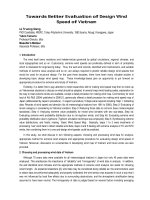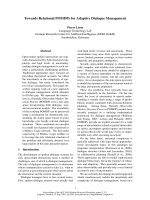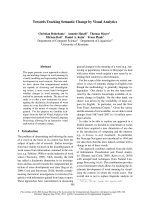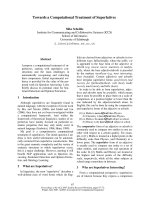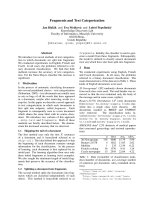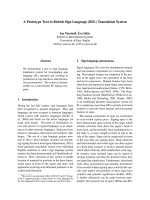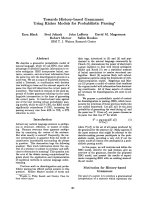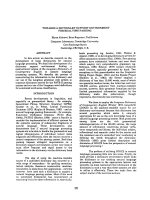Báo cáo khoa học: "Towards Interactive Text Understanding" ppt
Bạn đang xem bản rút gọn của tài liệu. Xem và tải ngay bản đầy đủ của tài liệu tại đây (120.34 KB, 4 trang )
Towards Interactive Text Understanding
Marc Dymetman* Aurélien Max*
+
Kenji Yamada*
(*) Xerox Research Centre Europe, Grenoble
(
+
) CLIPS-GETA, Université Joseph Fourier, Grenoble
{marc.dymetman,aurelien.max,}
Abstract
This position paper argues for an interactive
approach to text understanding. The proposed
model extends an existing semantics-based
text authoring system by using the input text
as a source of information to assist the user in
re-authoring its content. The approach per-
mits a reliable deep semantic analysis by
combining automatic information extraction
with a minimal amount of human interven-
tion.
1 Introduction
Answering emails sent to a company by its cus-
tomers — to take just one example among many
similar text-processing tasks — requires a reli-
able understanding of the content of incoming
messages. This understanding can currently only
be done by humans, and represents the main bot-
tleneck to a complete automation of the process-
ing chain: other aspects could be delegated to
such procedures as database requests and text
generation. Current technology in natural lan-
guage understanding or in information extraction
is not at a stage where the understanding task can
be accomplished reliably without human inter-
vention.
In this paper, which aims at proposing a fresh
outlook on the problem of text understanding
rather than at describing a completed implemen-
tation, we advocate an interactive approach
where:
1. The building of the semantic representation
is under the control of a human author;
2. In order to build the semantic representa-
tion, the author interacts with an intuitive textual
interface to that representation (obtained from it
through an NLG process), where some “active”
regions of the text are associated with menus that
display a number of semantic choices for incre-
menting the representation;
3. The raw input text to be analyzed serves as
a source of information to the authoring system
and permits to associate likelihood levels with
the various authoring choices; in each menu the
choices are then ranked according to their likeli-
hood, allowing a speedier selection by the au-
thor; when the likelihood of a choice exceeds a
certain threshold, this choice is performed auto-
matically by the system (but in a way that re-
mains revisable by the author).
4. The system acts as a flexible understanding
aid to the human operator: by tuning the thresh-
old at a low level, it can be used as a purely
automatic, but somewhat unreliable, information
extraction or understanding system; by tuning the
threshold higher, it can be used as a powerful
interactive guide to building a semantic interpre-
tation, with the advantage of a plain textual inter-
face to that representation that is easily
accessible to general users.
The paper is organized as follows. In section
2, we present a document authoring system,
MDA, where the author constructs an internal
semantic representation, but interacts with a tex-
tual realization of that representation. In section
3, we explain how such a system may be ex-
tended into an Interactive Text Understanding
(ITU) aid. A raw input document acts as an in-
formation source that serves to rank the choices
proposed to the author according to their likeli-
hood of “accounting” for information present in
the input document. In section 4, we present cur-
rent work on using MDA for legacy-document
normalization and show that this work can pro-
vide a first approach to an ITU implementation.
In section 5, we indicate some links between
these ideas and current work on interactive statis-
tical MT (TransType), showing directions to-
wards more efficient implementations of ITU.
2 MDA: A semantics-based document au-
thoring system
The MDA (Multilingual Document Authoring)
system [Brun et al 2000] is an instance (de-
scended from Ranta’s Grammatical Framework
[Ranta 2002]) of a text-mediated interactive
natural language generation system, a notion in-
troduced by [Power and Scott 1998] under the
name of WYSIWYM. In such systems, an author
gradually constructs a semantic representation,
but rather than accessing the evolving representa-
tion directly, she actually interacts with a natural
language text generated from the representation;
some regions of the text are active, and corre-
spond to still unspecified parts of the representa-
tion; they are associated with menus presenting
collections of choices for extending the semantic
representation; the choices are semantically ex-
plicit and the resulting representation contains no
ambiguities. The author thus has the feeling of
only interacting with text, while in fact she is
building a formal semantic object. One applica-
tion of this approach is in multilingual authoring:
the author interacts with a text in her own lan-
guage, but the internal representation can be used
to generate reliable translations in other lan-
guages. Fig. 1 gives an overview of the MDA
architecture and Fig. 2 is a screenshot of the
MDA interface.
Fig. 1: Authoring in MDA. A “semantic grammar” defines
an enumerable collection of well-formed partial semantic
structures, from which an output text containing active re-
gions is generated, with which the author interacts.
Fig. 2: Snapshot of the MDA system applied to the author-
ing of drug leaflets.
3 Interactive Text Understanding
In the current MDA system, menu choices are
ordered statically once and for all in the semantic
grammar
1
. However, consider the situation of an
author producing a certain text while using some
input document as an informal reference source.
It would be quite natural to assume that the au-
thoring system could use this document as a
source of information in order to prime some of
the menu choices.
Thus, when authoring the description of a phar-
maceutical drug, the presence in the input docu-
ment of the words tablet and solution could serve
to highlight corresponding choices in the menu
corresponding to the pharmaceutical form of the
drug. This would be relatively simple to do, but
one could go further: rank menu choices and as-
sign them confidence weights according to tex-
tual and contextual hints found in the input
document. When the confidence is sufficiently
high, the choice could then be performed auto-
matically by the authoring system, which would
produce a new portion of the output text, with the
author retaining the ability of accepting or reject-
ing the system’s suggestion. In case the confi-
dence is not high enough, the author’s choice
would still be sped up through displaying the
most likely choices on top of the menu list.
Fig. 3: Interactive Text Understanding.
This kind of functionality is what we call a text-
mediated interactive text understanding system,
or for short, an ITU system (see Fig. 3).
2
1
While the order between choices listed in a menu does not
vary, certain choices may be filtered out depending on the
current authoring context; this mechanism relies on unifica-
tion constraints in the semantic grammar.
2
Note that we do not demand that the semantic representa-
tion built with an ITU system be a complete representation
of the input document, rather it can be a structured descrip-
tion of some thematic aspects of that document. Similarly, it
is OK for the input document not to contain enough infor-
mation permitting the system or even the author to “answer”
certain menus: then some active regions of the output text
remain unspecified.
We will now consider some directions to im-
plement an ITU system.
4 From document normalization to ITU
A first route towards achieving an ITU system is
through an extension of ongoing work on docu-
ment normalization [Max and Dymetman 2002,
Max 2003]. The departure point is the following.
Assume an MDA system is available for author-
ing a certain type of documents (for instance a
certain class of drug leaflets), and suppose one is
presented a “legacy” document of the same type,
that is, a document containing the same type of
information, but produced independently of the
MDA system; using the system, a human could
attempt to “re-author” the content of the input
legacy document, thus obtaining a normalized
version of it, as well as an associated semantic
representation.
An attempt to automate the re-authoring proc-
ess works as follows. Consider the virtual space
of semantic representations enumerated by the
MDA grammar. For each such representation,
produce, through the standard MDA realization
process
3
a certain more or less rough “descriptor”
of what the input text should contain if its con-
tent should correspond to that semantic represen-
tation; then define a similarity measure between
this descriptor and the input text; finally perform
an admissible heuristic search [Nilsson 1998] of
the virtual space to find the semantics whose de-
scriptor has the best similarity with the input text.
This architecture can accomodate more or less
sophisticated descriptors: from bags of content-
words to be intersected with the input text, up to
predicted “top-down” predicate-argument tuples
to be matched with “bottom-up” tuples extracted
from the input text through a rough information-
extraction process.
Up to now the emphasis of this work has been
more on automatic reconstruction of a legacy
document than on interaction, but we have re-
cently started to think about adapting the ap-
proach to ITU. The heuristic search that we
mentioned above associates with a menu choice
an estimate of the best similarity score that could
be obtained by some complete semantic structure
extending that choice. It is then possible to rank
choices according to that heuristic estimate (or
some refinement of it obtained by deepening the
3
Which was initially designed to produce parallel texts in
several languages, but can be easily adapted to the produc-
tion of non-textual “renderings” of the semantic representa-
tions.
search a few steps down the line), and then to
propose to the author a re-ranked menu.
While we are currently pursuing this promis-
ing line of research because of its conceptual and
algorithmic simplicity, it has some weaknesses.
It relies on similarity scores between an input
text and a descriptor that are defined in a some-
what ad hoc manner, it depends on parameters
that are fixed a priori rather than by training, and
it is difficult to associate with confidence levels
having a clear interpretation.
A way of solving these problems is to move
towards a more probabilistic approach that com-
bines advantages of being built on accepted prin-
ciples and of having a well-developed learning
theory. We finally turn our attention to existing
work in this area that holds promise for improv-
ing ITU.
5 Towards statistical ITU
Recent research on the interactive statistical ma-
chine translation system TransType [Foster et al,
1997; Foster et al, 2002] holds special interest in
relation to ITU. This system, outlined in Fig. 4,
aims at helping a translator type her (uncon-
strained) translation of a source text by predict-
ing sequences of characters that are likely to
follow already typed characters in the target text;
this prediction is done on the basis of informa-
tion present in the source text. The approach is
similar to standard statistical MT
4
, but instead of
producing one single best translation, the system
ranks several completion proposals according to
a probabilistic confidence measure and uses this
measure to optimize the length of completions
proposed to the translator for validation. Evalua-
tions of the first version of TransType have al-
ready shown significant gains in terms of the
number of keystrokes needed for producing a
translation, and work is continuing for making
the approach effective in real translation envi-
ronments.
If we now compare Fig. 3 and Fig. 4, we see
strong parallels between TransType and ITU:
language model enumerating word sequences vs
4
Initially statistical MT used a noisy-channel approach
[Brown et al. 1993]; but recently [Och and Ney 2002] have
introduced a more general framework based on the maxi-
mum-entropy principle, which shows nice prospects in
terms of flexibility and learnability. An interesting research
thread is to use more linguistic structure in a statistical
translation model [Yamada and Knight 2001], which has
some relevance to ITU since we need to handle structured
semantic data.
grammar enumerating semantic structures,
source text vs input text as information sources,
match between source text and target text vs
match between input text and semantic structure.
In TransType the interaction is directly with the
target text, while in ITU the interaction with the
semantic structure is mediated through an output
text realization of that structure. We can thus
hope to bring some of the techniques developed
for TransType to ITU, but let us note that some
of the challenges are different: for instance train-
ing the semantic grammars in ITU cannot be
done on a directly observable corpus of texts.
5
Fig. 4: TransType.
6 Conclusion
We have introduced an interactive approach to
text understanding, based on an extension to the
MDA document authoring system. ITU at this
point is more a research program than a com-
pleted realization. However we think it repre-
sents an exciting direction towards permitting a
reliable deep semantic analysis of input docu-
ments by complementing automatic information
5
Let us briefly mention that we are not the first to note for-
mal connections between natural language understanding
and statistical MT. Thus, [Epstein 1996], working in a non-
interactive framework, draws the following parallel between
the two tasks: while in MT, the aim is to produce a target
text from a source text, in NLU, the aim is to produce a
semantic representation from an input text. He then goes on
to adapt the conventional noisy channel MT model of
[Brown et al 1993] to NLU, where extracting a semantic
representation from an input text corresponds to finding:
argmax(Sem) {p(Input|Sem) p(Sem)}, where p(Sem) is a
model for generating semantic representations, and
p(Input|Sem) is a model for the relation between semantic
representations and corresponding texts. See also [Berger
and Lafferty 1999] and [Knight and Marcu 2002] for paral-
lels between statistical MT and Information Retrieval and
Summarization respectively. On a different plane, in the
context of interactive NLG, [Nickerson 2003] has recently
proposed to rank semantic choices according to probabilities
estimated from a corpus; but here the purpose is not text
understanding, but improving the speed of authoring a new
document from scratch.
extraction with a minimal amount of human in-
tervention for those aspects of understanding that
presently resist automation.
Acknowledgements
Thanks for discussions and advice to C. Boitet,
C. Brun, E. Fanchon, E. Gaussier, P. Isabelle, G.
Lapalme, V. Lux and S. Pogodalla.
References
[Berger and Lafferty 1999] Information Retrieval as
Statistical Translation, SIGIR-99
[Brown, Della Pietra, Della Pietra and Mercer 1993]
The Mathematics of Statistical Machine Transla-
tion: Parameter Estimation. Computational Linguis-
tics 19(2), 1993
[Brun, Dymetman and Lux 2000]. Document Struc-
ture and Multilingual Text Authoring, INLG-2000
[Epstein 1996] Statistical Source Channel Models for
Natural Language Understanding, PhD Thesis, New
York University, 1996.
[Foster, Isabelle and Plamondon, 1997] Target-Text
Mediated Interactive Machine Translation, Machine
Translation, 12:1-2, 175-194, Dordrecht, Kluwer,
1997.
[Foster, Langlais and Lapalme, 2002] User-Friendly
Text Prediction for Translators, EMNLP-02
[Knight and Marcu 2002] Summarization beyond
sentence extraction: A Probabilistic Approach to
Sentence Compression, Artificial Intelligence,
139(1), 2002.
[Max and Dymetman 2002] Document Content
Analysis through Fuzzy Inverted Generation, in
AAAI 2002 Spring Symposium on Using (and Ac-
quiring) Linguistic (and World) Knowledge for In-
formation Access, 2002
[Max 2003]. Reversing Controlled Document Author-
ing to Normalize Documents. In the proceedings of
the EACL-03 Student Research Workshop, 2003
[Nickerson 2003]. Statistical Models for Organizing
Semantic Options in Knowledge Editing Interfaces.
In AAAI Spring Symposium workshop on natural
language generation in spoken and written dialogue,
2003.
[Nilsson 1998] Artificial Intelligence: a New Synthe-
sis. Morgan Kaufmann, 1998.
[Och and Ney 2002] Discriminative Training and
Maximum Entropy Models for Statistical Machine
Translation, ACL02
[Power and Scott 1998] Multilingual Authoring using
Feedback Texts. COLING/ACL-98.
[Ranta 2002] Grammatical Framework: A Type-
Theoretical Grammar Formalism, Journal of Func-
tional Programming, September 2002.
[Yamada and Knight 2001] A Syntax-based Transla-
tion Model, ACL-01.
